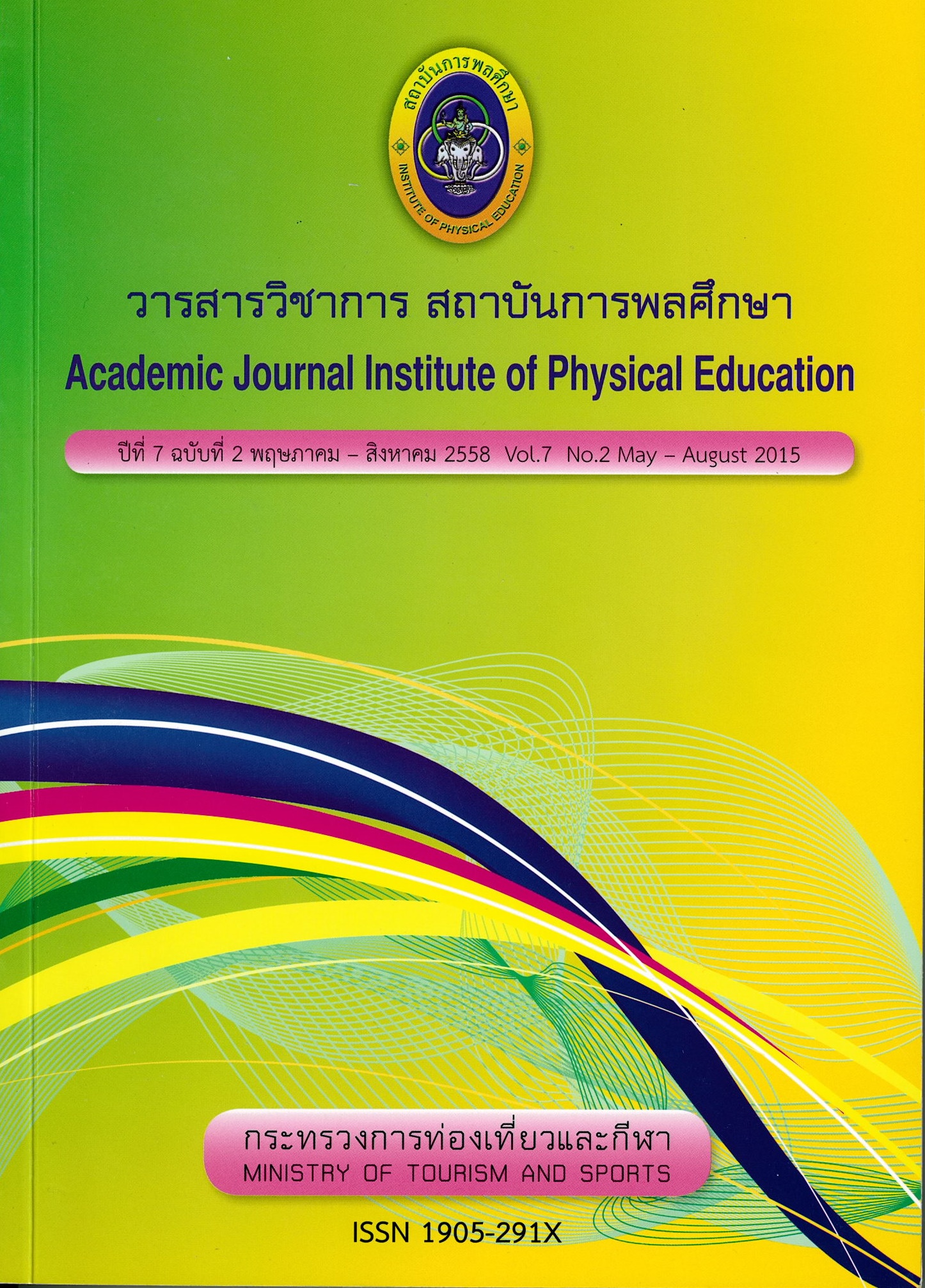Effect of Low Volume High Intensity Interval Training on Body Weight and Physical Fitness of Wrestlers
Main Article Content
Abstract
The objective of this research was to compare the effect of interval training programs to regular training on success rate of weight loss and physical fitness in wrestles. The eighteen wrestler athletes (aged between 18-24 years) 11 males and 7 females were randomly selected equally into two groups;a experimental group who undertook interval training program at intensity of 80-90 percent of MHR (8 sce. 120-130 prm with 12 sce. 40 rpm) 20 min along with usual training program (n=9), and an control group who undertook only usual training program (n=9). Both groups participated in an 8 weeks training program, three days a week. The variables studied were body weight, body composition, physical fitness (leg strength, maximum oxygen uptake, anaerobic
anaerobic capacity). Dependent t-test and Independent t-test were used for
pre-training and post-training data analysis. Significant level was set at .05
The results showed that after 8 weeks of interval training programs, significant (p< 0.05) decrease in Body weight (64.8+16.0 to 62.4+15.1) and BMI (23.8+5.3 to 23.0+5.0) in experimental group. %Fat, FM and FFM were no significant differences between groups. Significant (p< 0.05) increase in leg strength (143.8+38.1 to 188.5+54.1), maximum oxygen uptake (40.245.9 to 45.2+6.7) and anaerobic capacity (6.8+0.9 to 7.3+0.9) in experimental group. Anaerobic power were no significant differences between groups.
It was concluded that interval training program at intensity of 80-90 percent of MHR (8 sce. 120-130 prm with 12 sce. 40 rpm/ 20 min in 3 day a week/ overall 8 weeks) was the most effective for controling and reducing weight without affecting the physical fitness.
Article Details

This work is licensed under a Creative Commons Attribution-NonCommercial-NoDerivatives 4.0 International License.
The published article is a copyright of the Academic Journal of Thailand National Sports University. The passage appeared in each article in this academic journal is a perspective of each author which is not related to the journal. Each author is required to be responsible for all components of his/her own article. If there are any mistakes, each author must be responsible for those mistakes on his/her own.
References
กรมอนามัย (2543). เกณฑ์อ้างอิง น้ําหนัก ส่วนสูง และเครื่องชี้วัด ภาวะโภชนาการของประชาชนไทยอายุ 1 วัน-19 ปี, กองโภชนาการ กรมอนามัย กระทรวงสาธารณสุข.
ถาวรินทร รักษ์บํารุง. (2544). ผลการฝึกออกกําลังกายด้วยความเข้มข้น ระยะเวลาและความบ่อยที่แตกต่างกันต่อสมรรถภาพทางกาย. วิทยานิพนธ์วิทยาศาสตร์มหาบัณฑิต, สาขาวิทยาศาสตร์การออกกําลังกายและการกีฬา, บัณฑิตวิทยาลัย, มหาวิทยาลัยบูรพา.
ประทุม ม่วงมี. (2527), รากฐานทางสรีรวิทยา, กรุงเทพฯ: สํานักพิมพ์บูรพาสาส์น.
ประทุม ม่วงมี. (2532), อินเทอร์วาลเทรนนิ่ง คู่มือการฝึกกีฬา, กรุงเทพฯ: อมรการพิมพ์.
ปิยาวัฒน์ ศรีสวัสดิ์นุภาพ, วิภาวรรณ ลีลาสําราญ, และวุฒิชัย เพิ่มศิริวาณิชย์. (2554). การศึกษาองค์ประกอบทางร่างกายและ ร้อยละไขมันในนักกีฬายูโดเยาวชนไทยกลุ่มที่ได้รับชัยชนะกับไม่ได้รับชัยชนะ, เวชศาสตร์ฟื้นฟูสาร, 21(2), 68-72.
วรรณี แกมเกตุ. (2551). วิธีวิทยาการวิจัยทางพฤติกรรมศาสตร์ = Research methodology in.
วิรัตน์ สนจันทร์. (2555), ผลของการฝึกแบบอินเทอร์วาลในระดับความหนักและระยะเวลาต่างกัน ที่มีต่อความสามารถสูงสุดในการนําออกซิเจนไปใช้ ปริมาณฮีโมโกลบิน สมรรถภาพเชิงแอนแอโรบิก และ แอนแอโรบิกเทรชโฮล. ดุษฎีนิพนธ์วิทยาศาสตร์ปรัชญาดุษฎีบัณฑิต สาขาวิทยาศาสตร์การออกกําลังกายและการกีฬา, บัณฑิตวิทยาลัย, มหาวิทยาลัยบูรพา,
Artioli GG, Gualano B, Franchini E, Scagliusi FB, Takesian M, Fuchs M, & Lancha AH Jr. (2010). Prevalence, magnitude, and methods of rapid weight loss among judo competitors. Medicine & Science in Sports & Exercise, 42(3), 436-442.
Forster, C., Poole, C., Bushey, B., & Wilborn, C., (2009). Interval vs. Continuous training methods produce both different and similar effects on physiological measures. Medicine & Science in Sports & Exercise, 16(1), 2897. Retrieved November 16, 2013, Form www.acsm.org
Hetlelid, Ken J. Herold, Eva. & Seiler, Stephen. (2009). Comparison of Metabolic Responses to High Intensity Interval Training In Trained And Well-trained Males. International Journal of Sports Medicine, 41(5), p 501.
Kim S, Greenwell TC, Andrew DPS, Lee J, & Mahony DF. (2008). An analysis of spectator motives in an individual combat sport: a study of mixed martial arts fans. Sport Marketing Quarterly, 17(2), 109-119.
King, J. Broeder, C. Browder, K. & Panton, L. (2002). A Comparison of Interval Vs. Steady State Exercise on Substrate Utilization in Overweight Women. International Journal of Sports Medicine, 34(5), s 130.
M. Heydari, J. Freund, and S. H. Boutcher.( 2012). The Effect of High-Intensity Intermittent Exercise on Body Composition of Overweight Young Males. Journal of Obesity, 1-8.
Mahdi Bayati, Babak Farzad, Reza Gharakhanlou & Hamid Agha-Alinejad. (2011). A practical model of low-volume high-intensity interval training induces performance and metabolic adaptations that resemble 'all-out' sprint interval training. Journal of Sports Science and Medicine, 10, 571-576.
McArdle, W.D., Katch, F.L., & Katch, V.L. (2007). Essentials Of Exercise Physiology. (ond ed.). Lippincott: William & Wilkins.
Mehdi Abbaszadegan, Alireza Ramezani, & Mohammad Ali Azarbayjani. (2012). Comparison of physiological characteristics and physical fitness of junior young students in freestyle and Greco-roman wrestling. Scholars Research Library Annals of Biological Research, 3 (7), 3229-3233.
Ministry of Public Health. (2003). Dietary reference intake tables for Thais 2003. Bangkok; Nutrition Division Department.
Wilmore, J., Costill, D., & Kenney, W. (2008). Physiology of Sport and Exercise. Champaign, IL: Human Kinetics.

